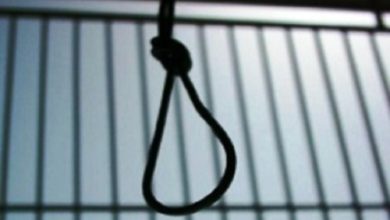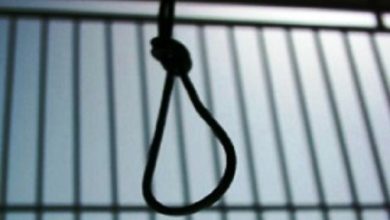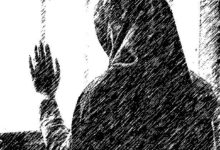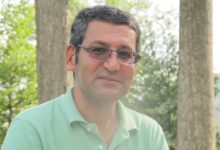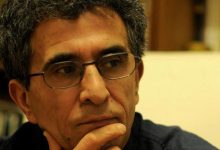Witness Statement of Heshmat Mostafa Soltani
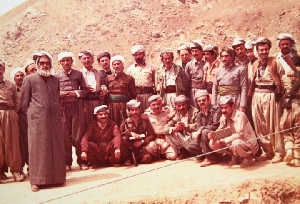 Picture of Sheikh Ezzedin Hosseini (far left) and Abdullah Mohtadi (far right) with members of Komala circa 1980. |
|---|
Name: Heshmat Mostafa Soltani
Place of Birth: Mariwan, Iran
Date of Birth: May 29, 1965
Occupation: Student
Interviewing Organization: Iran Human Rights Documentation Center (IHRDC)
Date of Interview: February 10, 2011
Interviewer: IHRDC Staff
This statement was prepared pursuant to an in person interview with Heshmat Mostafa Soltani. The statement was approved by Heshmat Mostafa Soltani on September 4, 2011. There are 45 paragraphs in the statement.
The views and opinions of the witness expressed herein do not necessarily reflect those of the Iran Human Rights Documentation Center.
Statement
1. My name is Heshmat Mostafa Soltani. I was born on May 29, 1965. I left Iran in November of 1983 and went to Iraqi Kurdistan. I left Iran because of my opposition to the regime of the Islamic Republic.
2. After the Revolution in 1979, I lost five of my brothers to the regime of the Islamic Republic. Two of my brothers, Hossein and Amin Mostafa Soltani, were executed on the order of Khalkhali[1] in 1979. Another brother, Foad Mostafa Soltani, was felled in battle against the regime not too long afterwards. Two other brothers, Majed and Amjad Mostafa Soltani, were executed by the regime in 1981.
Fall of the Shah and a Free Kurdistan
3. On February 11, 1979, I was in Mariwan.[2] I was 17 years old at the time. Like the rest of Iran, all Kurdish cities took part in combating the Shah’s regime and fighting for freedom, democracy and more rights for the people. Along these lines, extensive demonstrations took place in most Kurdish cities until the downfall of the Regime.
4. Until that point, Kurdistan shared the same fate as the rest of Iran but in those initial days of the downfall of the Shah’s regime, it became clear that Kurdistan was distinct from the rest of Iran in certain respects. For example, the spirit of religious fanaticism present in uprisings in other cities was absent in Kurdistan. Also, historically Kurdistan had largely secular political parties. So religious tendencies (that were not Shi’a and instead, if any, were Sunni) were not very deep rooted in the people. Therefore, the slogans and demands of the people were generally not religious.
5. Another difference that existed between Kurdistan and other parts of the country was that the people of Kurdistan were not going to let these freedoms slip away easily. They were free and armed. They had political parties and the secular wave and the desire to remove the national oppression had come together to enhance the Kurdish population’s political participation.
6. Kurdistan was a nation oppressed. Kurds desired the removal of this national oppression. The Revolution provided an opportune moment for the Kurdish people to announce their demands and ask for increased autonomy.
7. To this effect, many protests and demonstrations took place. The political forces in Kurdistan had a long history of partisanship, and at times, armed fighting. The people of Kurdistan were armed and did not hand over their arms to the newly founded regime. To the contrary, they stormed military and law enforcement bases and took their arms.
8. The regime could not easily disarm the people of Kurdistan and take away the freedoms they had achieved. However the regime wanted to disrupt the situation by whatever means necessary.
9. (One reason behind the desire to disturb the order in Kurdistan) was the Islamic Republic Election [referendum], in which 98% of the people of Kurdistan voted ‘No’ to an Islamic Republic regime. At the time of the voting, all the influential political parties in Kurdistan distanced themselves from the voting. They made announcements stating that it was very undemocratic to put to vote a question with only the choices ‘yes’ or ‘no.’ Also, people had the mindset that a religious government is not a good idea.
10. The ballot boxes were completely empty in Kurdistan and people didn’t participate in the voting. Ahmad Moftizadeh’s group was one of the few groups who participated in the voting and their numbers were at best 1% of the Kurdish population.
11. Moftizadeh was connected to the regime and wanted to implement their policies but was not liked by the Kurdish people. He trivialized the real demands of the Kurdish people by giving the demands a religious flavor.
12. The boycott of the referendum was an important occurrence that caused the IRI to further want to disrupt the situation in Kurdistan by whatever means necessary and wage war and unrest in that region.
Bloody Nowruz in Sanandaj and Other Tensions between Kurds and Pro-Government Forces
13. Even before the referendum, pro-government forces incited ethnic and tribal tendencies. They installed puppet groups like that headed by Ahmad Moftizadeh to cause rifts and chasms between groups and start a war so that they could bring their own government troops to Kurdistan.
14. A perfect example of the consequences of this was the Bloody Nowruz of Sanandaj that took place barely a month after the revolution. Only 30 days following the Revolution, the city of Sanandaj came under mortar attack from the government and many people died. In Sanandaj, quarrels between Khomeini’s representative Safdari and Moftizadeh in effect caused a war and bloodshed to start. This was barely a month after the revolution.
15. The people had enough might to resist the attacks. Rafsanjani, Beheshti, Bani Sadr, Haj Seyyed Javadi and others all came to Kurdistan to negotiate with the people and the City Council. The central government didn’t want to recognize the existing City Council that was voted into office by the people from the members of various political and religious groups and trade unions. However the people stood their ground and imposed their will on the central government.
16. The government’s next move was the war in Naghadeh. On March 29, 1979, the regime caused a rift between the Kurds and the Turks in the city of Naghadeh that resulted in a bloody massacre. Fighting started between these people who were otherwise coexisting harmoniously up until then.
Hostilities in Mariwan
17. For some time, the Moftizadeh clan set up head quarters in the city of Mariwan and intended to disrupt order by bombing and throwing grenades at the head quarters of the opposition. At the same time, IRI radio and television started a poisonous propaganda war against the Kurds of Iran. In protest to this negative propaganda, extensive demonstrations took place in various Kurdish cities against Ghotbzadeh [then head of radio and television] who said negative words against the Kurds.
18. On July 14, 1979, extensive demonstrations took place in all of Kurdistan. I participated in the demonstration in the city of Mariwan. The crowd went to the front of the radio – television building and protested the poisonous words of IRI and Ghotbzadeh. When they returned, the Moftizadeh clan and the pasdars present at the scene started shooting at the people. Three or four people were killed. The killings outraged people who in turn stormed the headquarters of Moftizadeh and the pasdars and killed twelve people.
19. While this was happening, the regime somehow found time to attack and occupy the city of Mariwan with the aim of starting a massacre like that in Naghadeh. To avoid this outcome, Foad Mostafa Soltani came up with the innovative idea of evacuating the people from the city and migrating en masse to the mountains. The migration of the people left the city empty (and removed the danger that they would become targets). Meanwhile, the peshmarga[3] prevented the pasdars from entering the city.
20. Finally, Lahuti and Chamran came to Mariwan and spoke with the City Council. They insisted that the actions of the people were incited by foreigners, like Israelis, and by military officers such as Palizban and Oveissi and others, however, in reality, they knew that the people who participated in the migration were the ordinary citizens of Mariwan and not foreigners. After two to three weeks, the Mariwan City Council was able to come to an agreement with Chamran and other officials. The agreement was that people would only return to Mariwan if the military left the city and left the protection of the city in the hands of the locals. Pasdars and military forces were not to intervene. The Kurds also agreed to be unarmed while in the city.
21. The people of Mariwan left the city on July 14 and returned on August 7, 1979. The agreements were going to be signed when regime forces started the war in Paveh.
Attack on Kurdistan in August 1979 & Execution of Hossein and Amin
22. As I said, during that time the regime was looking for an excuse to attack Kurdistan. Although the Kurds were armed they did not have orderly and organized forces or war experience. These guerilla fighters were not even weathered enough to be able to defend against the attack of the regime’s military. The regime, in turn, intended to attack Kurdistan when its forces were in disarray and unprepared and unorganized for a defense.
23. The regime started the war and bloodshed in Paveh. After that, on August 19, 1979, at 2 P.M., Khomeini said that communists and foreign forces took 500 women hostage in the central mosque of Sanandaj. He ordered all the youth and the Basij to go and release the women. This was untrue but it caused hoards of Hizbullahis to storm the city and kill whomever they could.
24. At that time, Khalkhali was dispatched to Paveh to execute groups of people, many of whom were arrested in the streets. Then, Khalkhali came to Mariwan and executed nine people. Two of those executed were my brothers, Hossein and Amin Mostafa Soltani, who were only imprisoned for 72 hours prior to execution. They were executed without going to court or with any possibility of defending themselves.
25. My father asked Khalkhali why Hossein and Amin were imprisoned and told him that his sons fought the Shah’s regime for democracy and freedom. Khalkhali responded “we will kill them; if you are correct then they will go to heaven. Otherwise, they have gotten what they deserved.”
26. My brothers were college graduates and teachers. One of them was in the Teachers Council of Mariwan which was an unarmed union. The other one was a member of the Peasants Peshmerga Union. They were Komala activists but unarmed when they were arrested.
27. From what I understand, they were arrested when they were trying to leave Mariwan. My brothers had no idea that the city was surrounded by pasdars but they knew that pasdars were coming to take over the city so they wanted to escape. Unfortunately as they tried to leave, forces connected to Ahmad Moftizadeh, who were Kurds themselves, recognized my brothers as Komala activists and arrested them. There were five people in the car and they were all executed. No one was told what their charges were.
Foad’s Death and More Negotiations
28. Waves of executions continued. Khalkhali went by helicopter to Saqqez where he ordered the execution of 23 people. Similar activities continued in all Kurdish cities. Despite this, the people of Kurdistan decided to defend against the attacks of the regime and started organizing their forces to resist the regime’s advances.
29. One of those organizing who was also a leader in Komala was my brother Foad Mostafa Soltani. When he heard about the execution of his brothers he left Baneh for Mariwan to organize troops there. On his return, a military group surrounded Foad and others, and my brother and another man from Mariwan were killed there.
30. Despite their death, their plan for organization was followed through and all the Kurdish people—from forces and the parties, to those who had no affiliation of any kind—widely participated in armed battles against the regime. For two to three months the people were able to paralyze all of the regime’s forces in Kurdistan.
31. For this reason, Khomeini decided to negotiate with the people of Kurdistan. In truth the negotiation was not intended for reaching an agreement with the people of Kurdistan, rather it was to buy time to refuel and reorganize the regime’s troops in order to crush the people again. During that time, the cities were in the hands of the people and the armed parties. They formed city councils to govern the cities. In truth, at that time, Kurdistan was the stronghold for freedom for all of Iran. And people from other parts of Iran came there. Publishing was open and speeches and meetings and gatherings were all being held in the Kurdish region.
32. Also, during that time, Sahabi and Forouhar and others came to negotiate with the Delegation of Representatives of the Kurdish People (DRKP). The DRKP was comprised of Sheikh Ezzedin Hosseini (who was the speaker of the committee), Dr. Ghassemlou (who represented the KDPI), and Abdullah Mohtadi and Dr. Shafi’ from the Komala. There were other members such as Behrouz Soleimani from the Fedaian-e Khalq Guerilla Organization and Yusef Ardalan and others. When the party representatives came to the negotiations each one of them had a group accompanying them. For example Sheikh Ezzedin wouldn’t go alone, but went with a committee of his own.
Second Wave of Attacks on Kurdistan & Execution of Majed and Amjad
33. The latest round of negotiations lasted until the spring of 1980 but then the regime felt it had the necessary power to crush all the Kurdish forces. Government forces started a war again, this time in Kamyaran, and occupied the town. Then Sanandaj was attacked in the spring of 1980, resulting in the 24-day war of Sanandaj. After 24 days of resistance by the Kurdish forces, the regime was able to take over the city. The Kurdish forces moved to the surrounding villages. This process lasted until the fall of 1983. The regime was able to take over all the cities, then the villages, and then the mountains and so the Kurdish forces moved to Iraq.
34. During that time, fighting against the regime continued in all the cities of Kurdistan and Iran but the bloody waves of executions continued as well and two of my other brothers, Amjad and Majed were executed. Majed was a medical student and Amjad studied electricity at Tabriz University. They were political activists and worked in Tabriz and Orumiyeh. They were politically active, wrote articles and publications against the regime and participated in meetings and discussions, collaborated on theoretical works with likeminded people and such.
35. They were arrested in Tabriz and executed the day after the Hafte Tir bombing by the MEK, on June 28, 1981.[4] They were unarmed at the time of the arrest.
36. Majed went to Tabriz University to visit a friend of his when he was arbitrarily arrested. With the aid of Tudeh members, Majed’s identity was discovered while he was in prison. He was subsequently linked to the political activities of my family and my other brothers.
37. My sister Fa’ezeh went to Tabriz with Amjad to see a doctor and they were arrested together in Majed’s friend’s house. She had her birth certificate with her and was easily identified. Although Amjad lived in hiding they were able to connect him to Fa’ezeh and identify him as well.
38. Majed was kept in prison for less than five months before he was executed. He was not identified until Amjad was arrested because he was living in secret and had a pseudonym. Once Amjad and Fa’ezeh were arrested they were able to identify Majed. I think Amjad was in prison for less than a month.
39. Before the uprising we formed a group called the Society of High School and College Students of Mariwan. I was a member of that society. After the uprising the society continued its activities and we participated in protests and discussions and meetings. We read books and informed the masses. Until the execution of Amjad and Majed such activities continued.
40. After that I wasn’t able to stay around my house any longer and I lived in the surrounding villages to prevent getting arrested. Following the executions, in the summer of 1981 I joined the peshmergas.
Structure of Komala
41. I was given responsibility in the central publication of Komala and worked on the typing, formatting and publication of Komala magazines. We were armed but didn’t participate in battles. Until 1988 I was with Komala in the mountains but then I left them. For one more year I did administrative work for them but then I left the party all together.
42. I wasn’t always in the publication and worked in other organs of Komala as well. For example, the division for Kurdish cities who was in contact with secret activists, organized and spoke to them and sent publications and met with the activists who would come to the mountains. Also, I worked in other divisions, such as in coordinating the sending and receiving messages of peshmergas in different areas.
43. The structure of today’s Komala is different but back then, every city had a committee called the Regional Committee that was elected by peshmergas. The elected committee acted as a leadership body for all the peshmergas in that region. The committee in turn had different divisions working on advertisement, villages and women and other matters. Their activities were two fold. One was informing the masses through speeches and discussions and organization among the masses and the other was armed combat against the regime such as occupying their bases and harming them. All the regions had the same organization.
44. Then there was the Central Committee that was elected by the Komala members. Every so many years a congress was formed through which the Central Committee was elected. The Committee would take care of the administrative aspects of the party for two or so years before another one was elected. This included advertisement, publication, newspaper, radio, organization, secret activists, city establishment, monetary, preparation and other divisions. It was a large establishment, an organized institution.
45. The major difference between Komala forces and civilians was that the former were armed. Also, Komala normally wore khaki colored clothing that was a bit different than the clothing of ordinary civilians. Still it was not like proper military uniforms of the same make and cut. Rather, their clothing was similar to clothes that normal people wore but were usually khaki colored.
[1] Mohammed Sadegh Khalkhali was a Shi’a cleric and served as the first Chief Justice of the Islamic Revolutionary Court. Known as the “hanging judge,” he was reportedly responsible for sentencing hundreds if not thousands of people to death.
[2] Mariwan, a town in Iran’s Kurdistan region, also alternatively appears as “Marivan” in the literature.
[3] Peshmerga, sometimes spelled peshmerge, is a term used by Kurds since the start of the Kurdish independence movement in the 1920s that literally means “those who face death”. The term is used quite broadly—the definition ranges in definition from Kurdish fighters to simply any civilian that is a supporter and defender of Kurdish civil and political rights.
[4] On June 28, 1981, a powerful bomb was detonated at the headquarters of the Islamic Republic Party in Tehran resulting in the death of 73 leading Iranian officials including the Chief Justice Ayatollah Beheshti. As the event followed a week of intensified conflict and street clashes between the authorities and the MEK, including a failed assassination attempt on the life of Ayatollah Khamenei, the president of the time, MEK is widely thought to have been behind the Hafte Tir bombing.



